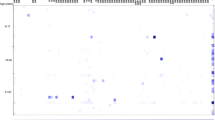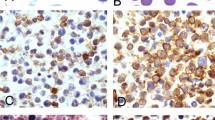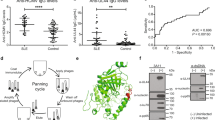Abstract
Background:
Kaposi's sarcoma-associated herpes virus is associated with primary effusion lymphoma and multicentric Castleman's disease.
Methods:
Seropositivity to lytic and latent Kaposi's sarcoma herpes virus (KSHV) antigens were examined in 2083 lymphomas and 2013 controls from six European countries.
Results:
Antibodies against KSHV latent and lytic antigens were detectable in 4.5% and 3.4% of controls, respectively, and 3.6% of cases (P>0.05). The KSHV seropositivity was associated with splenic marginal zone lymphoma (SMZL) (odds ratio (OR)=4.11, 95% confidence interval (CI)=1.57–10.83) and multiple myeloma (OR=0.31, 95% CI=0.11–0.85).
Conclusion:
The KSHV is unlikely to contribute importantly to lymphomagenesis among immunocompetent subjects. However, the observed association with SMZL may underline a chronic antigen mechanism in its aetiology.
Similar content being viewed by others
Main
Kaposi's sarcoma herpes virus (KSHV) also known as human herpes virus-8 is tightly associated with the development of Kaposi sarcoma (KS) and primary effusion lymphoma (PEL), and there is limited evidence of an association with multicentric Castleman's disease (MCD) (Bouvard et al, 2009). These malignancies occur more frequently in immunosupressed patients, particularly in human immunodeficiency virus (HIV)-infected subjects.
Literature is scarce in relation between KSHV infection and the development of non-Hodgkin lymphoma (NHL). In 2004, a case–control study carried out among immunocompetent patients in Spain failed to identify a major contribution of KSHV infection to lymphomagenesis. Although based on few cases, KSHV seropositive patients were more likely to have lymphoplasmacytic lymphoma and low-grade lymphoma (de Sanjose et al, 2004). A prospective study in the United Kingdom revealed that KSHV lytic and latent antibodies did not appear to be associated with NHL in HIV-infected individuals (Newton et al, 2006).
The aim of this study was to investigate the association between KSHV seropositivity and lymphoma subtypes in the multicenter European case–control study EpiLymph.
Materials and methods
Study population
Information was collected on 2362 incident lymphoma cases and 2465 controls during 1998–2003 in six countries (Germany, Italy, Spain, Ireland, France and Czech Republic). In Germany and Italy, population-based controls were sampled whereas, in all the other countries, hospital-based controls were recruited. The participation rate was 68.5% and 87.7% among controls and cases, respectively. The study has been described elsewhere (de Sanjose et al, 2006). All subjects signed an informed consent, and local ethics review committees approved the study. The KSHV serology was performed on 84% (n=2118) of cases and 82% (n=2048) of controls. After excluding immunosupressed patients, 2083 cases and 2013 controls were included in this study.
KSHV serology
All serum samples were tested for antibodies to KSHV lytic and latent antigens. Laboratory personnel performing the assay were blinded to patient disease status and demographic characteristics of the subjects. Details of the testing procedure are described elsewhere (Mbisa et al, 2010). Shortly, antibodies against the lytic antigen K8.1 and latent antigen LANA encoded by ORF73 were measured using an enzyme-linked immunosorbent assay (ELISA) based on recombinant proteins. A small set of samples from KS patients and a panel of 100 blood donor samples were run as ELISA positive and negative controls, respectively. OD cutoffs for seropositivity for each plate were defined as the average of negative controls plus 0.75 for the K8.1 ELISA and the average of the negative controls plus 0.35 for the ORF73 ELISA, to account for plate-to-plate variability. In validation studies using US blood donors and AIDS KS patients, the K8.1 assay has shown 98.78% sensitivity and 98.79% specificity, while the ORF73 assay had 89.02% sensitivity and 97.57% specificity (Mbisa et al, 2010).
Statistical analysis
Differences in KSHV seropositivity by categorical variables were done by means of a χ2-test. Unconditional logistic regression was used to estimate the odds ratios (ORs) and 95% confidence interval (95% CI) of lymphoma in relation to KSHV seropositivity. All models were adjusted for age, sex and country. Two-sided P-values were considered statistically significant at the 0.05 level. Heterogeneity among countries was evaluated with a likelihood ratio test comparing the model with and without interaction between country and exposure. We used the kappa (κ) statistic to describe the agreement between assays and the results of the two assays.
We carried out sensitivity analyses to evaluate the influence of country, type of control, cutoffs for seropositivity and age on our results, and to reduce the possibility of misclassification of the KSHV status. All the analyses were conducted using STATA (version 10.1, College Station, TX, USA) and R (version 2.10.1, 2009, The R Foundation for Statistical Computing, ISBN 3-900051-07-0).
Results
Table 1 shows the distribution of cases and controls and KSHV seroprevalence among controls according to demographic characteristics. The average age at entry was 56.4 (s.d.: 16.1) for cases and 56.2 for controls (s.d.: 16.4). Among controls, seropositivity was 4.5% for ORF73 (90 out of 2013) and 3.4% for K8.1 (68 out of 2013). The prevalence of anti-KSHV antibodies did not differ significantly by sex (P=0.5), increased linearly with age (P-trend <0.0001) and decreased with increasing educational level (P-trend=0.03) for latent antibodies. The highest seroprevalence was observed in Italy (12%). Similar pattern for K8.1 antibodies was observed in relation to demographic characteristics. Seropositivity among controls for both antibodies represented 2% (n=38). Overall, the pairwise agreement between ORF73 and K8.1 results among controls was moderate (κ=0.46), being good in the youngest (κ=0.61) and in the age group of 64 to 70 years old (κ=0.63) and in Italy (κ=0.74) (data not shown).
Table 2 shows the OR by lymphoma subtypes in relation to anti-KSHV antibody status. For all lymphoma, we observed no association with seropositivity to ORF73 (OR=0.78, 95% CI=0.57–1.07, seropositive cases/total cases N=75/2083) nor to K8.1 (OR=1.05, 95% CI=0.76–1.48, N=74/2083). By lymphoma subtype, CLL/SLL and MM cases were more likely to be seronegative to latent anti-KSHV antibodies than controls (OR=0.58, 95% CI=0.31–1.06, N=13/375 and OR=0.31, 95% CI=0.11–0.85, N=4/254, respectively). Antibodies against K8.1 antigen, but not for ORF73 antigen, showed a significant increased OR for splenic marginal zone lymphoma (SMZL) (OR=4.11, 95% CI=1.57–10.83, N=6/36). Although 70% (N=25) of SMZL cases came from Spain, sensitivity analyses on country did not modify the results (data not shown). We also observed a nonsignificant increased OR for mantle cell lymphoma (MCL) (OR=2.63, 95% CI=0.88–7.86, N=4/58). Further sensitivity analyses on age, type of control and OD cutoff variations did not change the results.
Discussion
This study analysed the association between antibodies against KSHV and lymphoma in the European case–control study EpiLymph. Overall, we found no association between positivity to lytic or latent antibodies against KSHV antigens and lymphoma. However, we observed an increased OR in SMZL and MCL, and a decreased OR in MM. Furthermore, our data support previous observations in which seropositivity to KSHV increases with increasing age and is higher in Italy than in other European countries (Whitby et al, 1998).
We observed that KSHV seroreactivity to lytic antigens increased four times the probability of SMZL. This was consistent with our previous results based on Spanish cases (de Sanjose et al, 2004). This analysis adds 11 further SMZL cases from 4 other countries reinforcing the association. The SMZL is a low-grade B-cell lymphoma belonging to the marginal zone lymphoma group that involves predominantly the spleen. There is amounting evidence that SMZL may be related to chronic antigen immune stimulation, in particular to chronic hepatitis C (HCV) (Suarez et al, 2006). The mechanism by which KSHV could induce SMZL is unclear. However, KSHV is a lymphotropic virus that can produce PEL, a large B-cell lymphoma arising in KSHV-associated MCD, and an entity named germinotropic lymphoproliferative disorder that has been described in the absence of HIV (Carbone et al, 2005). In addition, malignant cells from SMZL may be affected by microbial pathogens because they arise from marginal zone cells that are in the underlying pathways of the immune response to infection (Suarez et al, 2006). Further, KSHV is the aetiological trigger of KS in the elderly in the absence of HIV or HCV. All seropositive subjects in our analysis were HCV and HIV negative.
In our data, we detected a nonsignificant increased OR in MCL. To our knowledge, this has not been previously reported and we do not have a clear biological explanation. The MCL may be subject to histological classification (Weisenburger and Armitage, 1996). However, EpiLymph cases were reviewed by an international panel of pathologists, ruling out major misclassifications by lymphoma subtypes. Further studies should be relevant to help in the understanding of this association.
The observed reverse association of KSHV and MM is consistent with the literature (Rettig et al, 1997). We had previously reported within EpiLymph, lower antibody response to Helicobacter Pylori, simian virus 40 and Epstein-Barr virus (de Sanjose et al, 2007) in MM subjects compared with controls.
To our knowledge, this is the first study that evaluates the association between anti-KSHV antibody status and lymphoma among immunocompetent European subjects. We have enlarged the sample size of our previous study, including participants from four European countries to validate our previous finding and also to explore further the association with specific lymphoma subtypes. Sensitivity analyses, including variation of seropositivity cutoffs and age-matched analyses, supported that our results were not materially influenced by potential confounding factors. Serological evaluation of KSHV has not been standardised (Pellett et al, 2003) but the highest seroprevalence observed in Italy and the increasing antibody titres with age reinforce the validity of the assays. Besides, available data for KSHV prevalence of EpiLymph countries are comparable with our data (Whitby et al, 1998). Estimates from hospital-based case–control studies might be biased if the underlying KSHV prevalence in the control population affects hospitalisation rates owing to KSHV-related diseases. However, the results did not change materially after restricting the analyses to hospital or population case–control studies. We cannot also rule out that our results may be due to chance originating from the small KSHV seroprevalence by subtype.
In conclusion, our findings support an association with SMZL among immunocompetent subjects that deserves further research.
Change history
29 March 2012
This paper was modified 12 months after initial publication to switch to Creative Commons licence terms, as noted at publication
References
Bouvard V, Baan R, Straif K, Grosse Y, Secretan B, El GF, Benbrahim-Tallaa L, Guha N, Freeman C, Galichet L, Cogliano V (2009) A review of human carcinogens—Part B: biological agents. Lancet Oncol 10 (4): 321–322
Carbone A, Gloghini A, Vaccher E, Marchetti G, Gaidano G, Tirelli U (2005) KSHV/HHV-8 associated lymph node based lymphomas in HIV seronegative subjects. Report of two cases with anaplastic large cell morphology and plasmablastic immunophenotype. J Clin Pathol 58 (10): 1039–1045
de Sanjose S, Benavente Y, Nieters A, Foretova L, Maynadie M, Cocco PL, Staines A, Vornanen M, Boffetta P, Becker N, Alvaro T, Brennan P (2006) Association between personal use of hair dyes and lymphoid neoplasms in Europe. Am J Epidemiol 164 (1): 47–55
de Sanjose S, Bosch R, Schouten T, Verkuijlen S, Nieters A, Foretova L, Maynadie M, Cocco PL, Staines A, Becker N, Brennan P, Benavente Y, Boffetta P, Meijer CJ, Middeldorp JM (2007) Epstein-Barr virus infection and risk of lymphoma: immunoblot analysis of antibody responses against EBV-related proteins in a large series of lymphoma subjects and matched controls. Int J Cancer 121 (8): 1806–1812
de Sanjose S, Goedert JJ, Marshall V, Bellas C, Benavente Y, Bosch R, Domingo A, Fernandez de SA, Servitje O, Whitby D (2004) Risk of malignant lymphoma associated with human herpesvirus-8: a case-control study in Spain. Br J Cancer 90 (11): 2145–2148
Mbisa GL, Miley W, Gamache CJ, Gillette WK, Esposito D, Hopkins R, Busch MP, Schreiber GB, Little RF, Yarchoan R, Ortiz-Conde BA, Labo N, Whitby D (2010) Detection of antibodies to Kaposi's sarcoma-associated herpesvirus: a new approach using K8.1 ELISA and a newly developed recombinant LANA ELISA. J Immunol Methods 356 (1–2): 39–46
Newton R, Carpenter L, Casabonne D, Beral V, Babiker A, Darbyshire J, Weller I, Weiss R, Kwan A, Bourboulia D, Munoz F, Lagos D, Boshoff C (2006) A prospective study of Kaposi's sarcoma-associated herpesvirus and Epstein-Barr virus in adults with human immunodeficiency virus-1. Br J Cancer 94 (10): 1504–1509
Pellett PE, Wright DJ, Engels EA, Ablashi DV, Dollard SC, Forghani B, Glynn SA, Goedert JJ, Jenkins FJ, Lee TH, Neipel F, Todd DS, Whitby D, Nemo GJ, Busch MP (2003) Multicenter comparison of serologic assays and estimation of human herpesvirus 8 seroprevalence among US blood donors. Transfusion 43 (9): 1260–1268
Rettig MB, Ma HJ, Vescio RA, Pold M, Schiller G, Belson D, Savage A, Nishikubo C, Wu C, Fraser J, Said JW, Berenson JR (1997) Kaposi's sarcoma-associated herpesvirus infection of bone marrow dendritic cells from multiple myeloma patients. Science 276 (5320): 1851–1854
Suarez F, Lortholary O, Hermine O, Lecuit M (2006) Infection-associated lymphomas derived from marginal zone B cells: a model of antigen-driven lymphoproliferation. Blood 107 (8): 3034–3044
Weisenburger DD, Armitage JO (1996) Mantle cell lymphoma—an entity comes of age. Blood 87 (11): 4483–4494
Whitby D, Luppi M, Barozzi P, Boshoff C, Weiss RA, Torelli G (1998) Human herpesvirus 8 seroprevalence in blood donors and lymphoma patients from different regions of Italy. J Natl Cancer Inst 90 (5): 395–397
Acknowledgements
We would like to thank all those who took part in this study, providing questionnaire data and blood samples. This work was supported by a European Commission Grant no. QLK4-CT-2000-00422 (EpiLymph studies); Association pour la Recherche contre le Cancer (ARC no.5111); the Fondation de France (1999 008471; EpiLymphFrance); Compagnia di San Paolo di Torino, Programma Oncologia 2001 (EpiLymph-Italy); Italian Ministry of Education, University and Research (PRIN 2007, 2007WEJLZB); Spanish Ministry of Health grants RCESP (C03/09), RTICESP (C03/10), RTIC (RD06/0020/0095), CIBERESP (06/02/0073), FIS 08-1555 (EpiLymph-Spain) and from the Agència de Gestió d'Ajuts Universitaris i de Recerca – Generalitat de Catalunya (AGAUR 2005SGR 00695, AGAUR 2009SGR1465 and AGAUR 2009SGR126) who had no role in the data collection, analysis or interpretation of the results; the German Federal Ofce for Radiation Protection (StSch4261 and StSch4420; EpiLymp-Germany).
Author information
Authors and Affiliations
Corresponding author
Ethics declarations
Competing interests
The authors declare no conflict of interest.
Rights and permissions
From twelve months after its original publication, this work is licensed under the Creative Commons Attribution-NonCommercial-Share Alike 3.0 Unported License. To view a copy of this license, visit http://creativecommons.org/licenses/by-nc-sa/3.0/
About this article
Cite this article
Benavente, Y., Mbisa, G., Labo, N. et al. Antibodies against lytic and latent Kaposi's sarcoma-associated herpes virus antigens and lymphoma in the European EpiLymph case–control study. Br J Cancer 105, 1768–1771 (2011). https://doi.org/10.1038/bjc.2011.392
Received:
Revised:
Accepted:
Published:
Issue Date:
DOI: https://doi.org/10.1038/bjc.2011.392
Keywords
This article is cited by
-
Kaposi sarcoma
Nature Reviews Disease Primers (2019)



